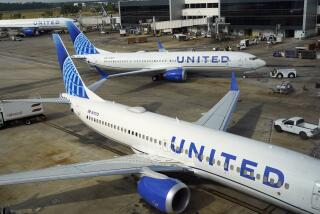Airlines get new tools to avoid turbulence

Students trying to overcome fear of flying experience simulated turbulence in a class in Pacoima. American Airlines and Alaska Airlines have been testing new sensors and software that relay information as a plane experiences turbulence.
- Share via
Airlines are using new software that transmits weather data from planes in the air to analysts on the ground, allowing pilots to avoid turbulence that can injure passengers and damage planes.
A passenger and two flight attendants were hospitalized Saturday after United Airlines flight 1597 ran into turbulence on the way into Washington Dulles International Airport from San Juan, Puerto Rico. A second flight also ran into strong turbulence while flying to Washington from San Francisco, but no serious injuries were reported.
To avoid such injuries, American Airlines and Alaska Airlines have been testing new sensors and software that relay information as a plane experiences turbulence and transmits it to other airlines. The software, made by Andover, Mass.-based WSI, could help aircraft prepare for turbulence or avoid it, the company says.
“Pilots would typically give you the report after the turbulence had abated,” said Des Keany, manager of flight planning and weather support for American Airlines. “Now, with this technology, the aircraft reports in real time.”
According to a study by the NASA Weather Accident Prevent Project, turbulence is a major cause of airline injuries and costs up to $100 million in damage each year. Each incident costs airlines between $28,000 and $167,000, the study estimated.
There have been between 12 and 76 injured passengers and crew members every year since 2002, according to the FAA.
Alaska Airlines said that improving safety was its first priority, but it’s also hoping the software could help cut maintenance costs.
In the past, when a plane ran into turbulence, pilots would decide whether the disturbance was severe enough to require maintenance. There have been instances in which pilots overestimated the severity of turbulence and requested unnecessary inspections, Keany said. Sensors and software installed by WSI, a division of the Weather Company, can measure turbulence intensity and provide information on whether the plane requires an inspection.
“This information is one piece of the puzzle in avoiding areas of turbulence,” said Halley Knigge, a spokeswoman for Alaska Airlines.
IPads are another tool pilots can use. American Airlines is starting to issue iPads to pilots to help them visualize inclement weather and potential areas of turbulence.
“The pilot can now see the routed flight plan and anything that’s along the track so they can determine where turbulence reports might be,” Keany said.
Another new piece of technology is the MultiScan ThreatTrack radar system, developed by Cedar Rapids, Iowa-based Rockwell Collins, which can detect hazardous weather up to 320 nautical miles away. These improved sensors scan horizontally and vertically for potential threats and can predict turbulence from thunderstorms as they develop.
“It scans these cells that could pose a threat to the aircraft,” said Andrea Huguely, American Airlines’ corporate communications director. “It infers lightning, hail and any type of convection threat.”
More to Read
Inside the business of entertainment
The Wide Shot brings you news, analysis and insights on everything from streaming wars to production — and what it all means for the future.
You may occasionally receive promotional content from the Los Angeles Times.










